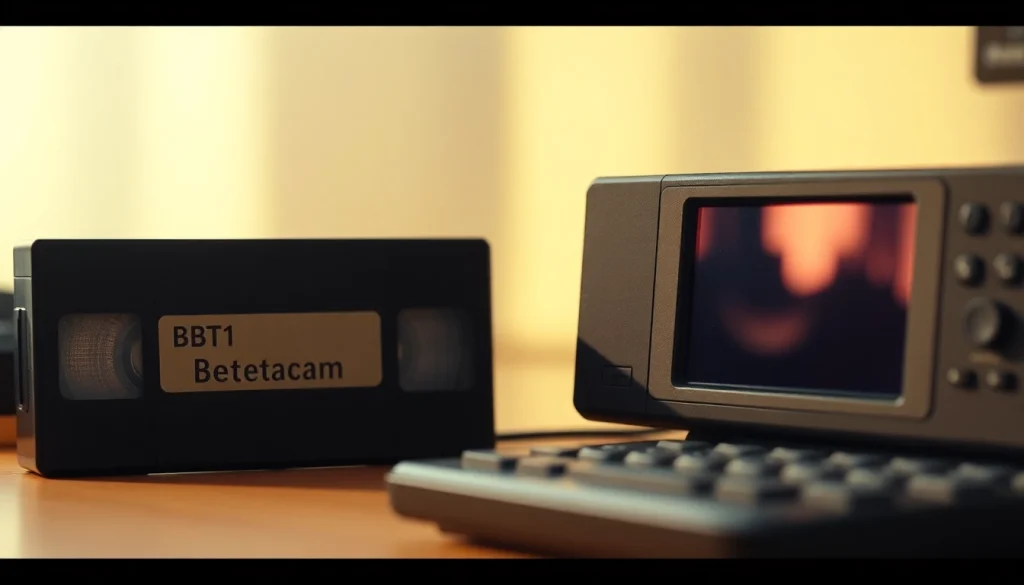
Understanding Betacam Tapes
What Are Betacam Tapes?
Betacam tapes are a family of Sony’s professional analog videocassette formats introduced in the 1980s. Designed primarily for broadcast and production environments, these tapes became a standard in the television and film industry. Though primarily an analog format, variants such as Betacam SP, Betacam SX, and Digital Betacam (DigiBeta) have emerged over time, each offering advancements in video quality, recording time, and reliability. As technologies advance, the importance of converting these tapes to digital formats becomes critical for preservation and accessibility.
Different Types of Betacam Formats
Understanding the different types of Betacam formats is crucial for selecting the right conversion process:
- Betacam: The original format introduced in 1982, featuring 2:1 component video recording.
- Betacam SP: Launched in 1986, it offered enhanced picture quality and recording efficiency, becoming the industry standard.
- Betacam SX: Introduced in the 1990s, using MPEG-2 compression to allow longer recording times and greater data efficiency.
- Digital Betacam (DigiBeta): Launched in 1993, this format used digital recording technology to provide superior video quality and reliability, making it a preferred choice for digital television and film production.
Why Convert Betacam to Digital?
Converting Betacam to Digital offers numerous benefits. As analog tapes degrade over time, converting them to a digital format ensures that the valuable content stored on these tapes is preserved for future generations. Digital files are easier to store, share, and edit, making it significantly more convenient for both personal and professional use. Moreover, digital formats are less susceptible to the deterioration commonly experienced by physical media, thus enhancing the longevity and accessibility of the stored videos.
The Benefits of Betacam to Digital Conversion
Preservation of Quality and Reliability
One of the principal advantages of converting Betacam tapes to digital is the preservation of video quality. Even the best analog tapes start to degrade with time, as they are susceptible to magnetic decay, environmental factors, and physical wear and tear. Digital formats, on the other hand, do not degrade over time in the same manner as tape. This means that once a Betacam tape is converted to a digital format, the quality remains consistent regardless of how often or how long the file is played. This consistency ensures that valuable footage does not fade or distort, which is particularly important for archival purposes.
Accessibility and Ease of Use
Digital formats provide superior accessibility compared to tapes. With digital files, individuals can easily share, edit, and distribute content without the need for specialized equipment. This accessibility opens up numerous possibilities, such as cloud storage solutions that allow remote access and editing capabilities from any device with internet connectivity. This contrasts sharply with the cumbersome setups often required for Betacam playback, making digital conversion essential for modern workflows in editing and distribution.
Cost-Effectiveness of Digital Storage
The long-term cost-effectiveness of digital storage cannot be overstated. While the initial conversion of Betacam tapes to digital may require a financial investment, the advantages far outweigh the costs over time. Digital storage solutions are not only cheaper per gigabyte compared to traditional tape and physical media, but they also require less physical space. Moreover, the maintenance costs associated with preserving physical tape libraries—which often include climate-controlled storage and playback equipment—can be considerable. Digital formats eliminate many of these ongoing expenses.
Choosing the Right Conversion Service
Factors to Consider When Selecting a Service
When selecting a service for Betacam to digital conversion, there are several critical factors to keep in mind:
- Equipment Quality: Ensure the service uses high-quality VTR (Video Tape Recorder) decks and digitizers, as the quality of the original tapes will significantly influence the final output.
- Expertise: Look for a company with experienced technicians knowledgeable about the specific Betacam formats. Their expertise can affect the conversion quality.
- Review Sampling: Try to find samples of their previous work. This will help you understand the quality of their conversions and whether it meets your expectations.
- Turnaround Time: Identify the timelines for conversion services. Occasionally, businesses may promise quick service but compromise on quality, so make sure to balance speed and quality.
Comparing Prices and Packages
Cost is often a deciding factor when choosing a conversion service. Prices may vary widely based on factors like tape length, conversion quality, and additional features such as color correction or editing. Compare quotes from several providers to get a clear picture of the market rates. Some companies may offer package deals or discounts for bulk transfers, so it’s worth inquiring about potential savings if you have multiple tapes to convert. However, do not choose solely based on the price; quality should take precedence.
Reading Customer Reviews and Feedback
Before committing to a service, take the time to read customer reviews and testimonials. Feedback from previous clients can provide valuable insights into the reliability and quality of the service. Pay attention to recurring themes in reviews, particularly regarding customer service, quality of work, and turnaround times. It can also be beneficial to seek recommendations from friends or colleagues who have experience with tape conversion services.
The Conversion Process Explained
Step-by-Step Guide to Betacam to Digital Conversion
The conversion process generally follows these steps:
- Initial Assessment: The conversion service will evaluate the condition of your Betacam tapes to determine the best approach for conversion.
- Preparation: Tapes are cleaned and tested for usability. Any necessary repairs are made before the conversion process starts.
- Digitization: Using high-quality VTR decks, the tapes are played back, and the content is recorded to a digital format such as MP4 or MOV.
- Editing (if required): Additional editing services may be performed upon request, including trimming, color correction, and enhancement.
- Final Quality Check: After conversion, the digital files undergo a quality check to ensure they meet the desired output standards.
- Delivery: The final digital files are delivered to the client via USB drive, cloud storage, or an online download link as per the agreement.
What to Expect During the Process
Clients can expect a straightforward process, but there may be variations depending on the specific service provider. Communication is essential, so ensure your chosen service provider keeps you updated on the conversion progress and addresses any concerns you may have. Set expectations regarding timelines and deliverables upfront to avoid misunderstandings. Additionally, make sure to ask about the file formats that will be used and any options for further digital backups.
Post-Conversion Quality Checks
Quality assurance is a vital part of the conversion process. After the conversion is complete, digital files should be closely reviewed to ensure they are free from defects and accurately reflect the original content. A good conversion service will often provide a sample of the digital output for client review prior to full delivery. If any issues arise, clients should be able to communicate effectively with the service provider for re-work or adjustments.
Frequently Asked Questions about Betacam to Digital
How Long Does Conversion Take?
The duration of the conversion process can vary widely based on several factors, including the number of tapes, the condition of the tapes, and the conversion service’s workload. Typically, you can expect a turnaround time ranging from a few days to several weeks. For bulk orders or more complicated conversions, it may take longer. It’s advisable to check with your chosen service provider for an estimated timeline once your project starts.
What Formats Are Available After Conversion?
Common digital formats available after the conversion process include MP4, MOV, AVI, and more. MP4 is generally the most widely accepted format because of its compatibility with various devices and playback software. Depending on your needs, some services may also offer DVD or Blu-ray formats for an additional cost. Make sure to specify your preferred format before the conversion begins to ensure that you receive the final outputs compatible with your intended use.
Can I Convert Multiple Tapes at Once?
Yes, many conversion services offer the option to convert multiple tapes simultaneously. In fact, bulk orders can often qualify for discounts. If you have a substantial library of Betacam tapes to digitize, inquire about any package deals or bulk pricing at your chosen service provider. Bringing multiple tapes can also help streamline the process, as technicians will be better equipped to handle related jobs more efficiently in one go.






